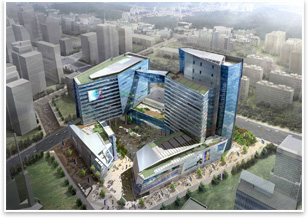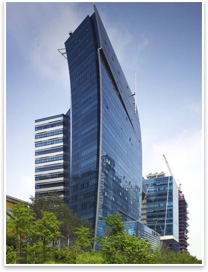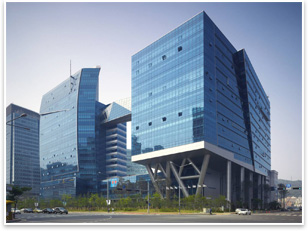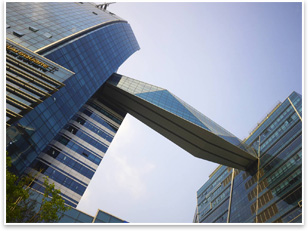
| NBBJ Opens Anchor for Seoul’s Digital Media City Nuritkum Square designed for all phases of IT business
A physical representation of South Korea’s rising technological might, Nuritkum Square occupies a prime corner in Seoul’s famed Digital Media City development, the country’s first endeavor to combine urban and economic development plans in a single location. The DMC is recognized as a significant step in nurturing social capital for Korea’s future development, and Nuritkum Square is poised to become the DMC’s business and IT hub.
“Korea is on the fast-track to becoming a leading nation in technology and digital media,” he explains. “The country’s IT industry has experienced rapid growth in the past 10 years, and, with the addition of the Digital Media City in Seoul, the growth in production is expected to continue. As a result, numerous developments are being created in the area to support this growth, including Nuritkum Square.”
Although the building is not LEED® certified, as part of the tendering requirements in the competition, a percentage of the development costs had to be allocated to sustainability. To achieve that goal, each building in Nuritkum Square features a green roof, and atop the R&D center a field of photovoltaics provides power to the facility. Mankin notes that the sustainability trend is gaining ground in South Korea. “I would say that three years ago it was very difficult to talk about it with a client,” he recalls. “It was not well understood, but now it is and there is a growing feeling of responsibility for using or implementing sustainable strategies.” |
||
Copyright 2008 The American Institute of Architects. All rights reserved. Home Page |
||
news headlines
practice
business
design
recent related
› New Songdo City Looks Back at the New World for Older Urban Models
› Five Basics You Need to Know to Play in Today’s Global Market
› Ten Things You’ll Want to Know About Working in Asia
Listen to “Opportunities Overseas,” a podcast presented by Department of Commerce Senior International Trade Specialist Mark Wells speaking with AIArchitect Executive Editor Doug Gordon.
Did you know?
The U.S. is not alone … Mankin reports that Asia also is experiencing a substantial slowdown in AEC work. “I would say [it’s slowing down] pretty much across the board in multiple countries, including China. I’m seeing it this week, actually, and it appears that it’s like in the U.S., predominantly in the commercial sector.”
All renderings are courtesy of NBBJ.
Knowledge Community
See what the AIA International Practice knowledge community is up to.
Do You Know SOLOSO?
The AIA’s resource knowledge base can provide you with information on how to best manage your practice’s international projects.
See what else SOLOSO has to offer for your practice.
From the AIA Bookstore
International Practice for Architects, by Bradford Perkins, FAIA (John Wiley and Sons, 2007).

 Summary:
Summary: Designed for the Korean IT Industry Promotion Agency by the Los Angeles office of NBBJ, Nuritkum Square offers nascent and burgeoning IT and media businesses, a business center, a research and development building, media production facilities, and an exhibition space known as the digital pavilion. NBBJ became involved with the project through a developer-led turnkey competition in the fall of 2004, says Principal Robert Mankin, AIA, who led the design process from concept design through construction.
Designed for the Korean IT Industry Promotion Agency by the Los Angeles office of NBBJ, Nuritkum Square offers nascent and burgeoning IT and media businesses, a business center, a research and development building, media production facilities, and an exhibition space known as the digital pavilion. NBBJ became involved with the project through a developer-led turnkey competition in the fall of 2004, says Principal Robert Mankin, AIA, who led the design process from concept design through construction. The $260 million complex is 22 stories high and occupies over 1.6 million square feet on the corner of Digital Media Street. The project visually and functionally anchors the DMC development, which includes offices, retail, and housing in a New Urbanist setting. “In the master plan, the real heart of [the DMC] is Digital Media Street, a pedestrian street that ultimately is going to be an area where new technologies like interactive mobile devices or interactive signage could be product tested,” Mankin says. “Digital Media Street is the heart of this whole district and our IT site anchors the east end. That’s the project that’ll be the gateway for the entire district.”
The $260 million complex is 22 stories high and occupies over 1.6 million square feet on the corner of Digital Media Street. The project visually and functionally anchors the DMC development, which includes offices, retail, and housing in a New Urbanist setting. “In the master plan, the real heart of [the DMC] is Digital Media Street, a pedestrian street that ultimately is going to be an area where new technologies like interactive mobile devices or interactive signage could be product tested,” Mankin says. “Digital Media Street is the heart of this whole district and our IT site anchors the east end. That’s the project that’ll be the gateway for the entire district.” Mankin says that the project’s four distinct programs were intended to accommodate the different stages of IT business and technology development so that ideas could be formed and shaped in the offices of the commercial building, developed and finalized in the R&D spaces, and brought to market through the production studio. Finally, new products are displayed for consumers in the digital pavilion, a gallery that was designed to exhibit experimental developments in technology and serve as a place to experience all types of digital content, including movies, games, and animation. A cocoon-like bridge connects the business center to the R&D building and houses the digital pavilion.
Mankin says that the project’s four distinct programs were intended to accommodate the different stages of IT business and technology development so that ideas could be formed and shaped in the offices of the commercial building, developed and finalized in the R&D spaces, and brought to market through the production studio. Finally, new products are displayed for consumers in the digital pavilion, a gallery that was designed to exhibit experimental developments in technology and serve as a place to experience all types of digital content, including movies, games, and animation. A cocoon-like bridge connects the business center to the R&D building and houses the digital pavilion. “The design responds to the project’s programmatic goals of including all stages of IT development,” believes Mankin. “It goes beyond these goals, however, by unifying each piece of the program with the Digital Media City, creating a collaborative space for the development of radically new ideas in Information technology.”
“The design responds to the project’s programmatic goals of including all stages of IT development,” believes Mankin. “It goes beyond these goals, however, by unifying each piece of the program with the Digital Media City, creating a collaborative space for the development of radically new ideas in Information technology.”